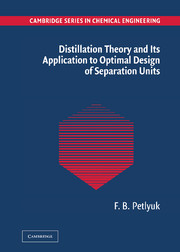Book contents
- Frontmatter
- Contents
- Preface
- Acknowledgements
- Nomenclature
- 1 Phase Equilibrium and Its Geometric Presentation
- 2 Basic Concepts of Distillation
- 3 Trajectories of Distillation in Infinite Columns Under Infinite Reflux
- 4 Trajectories of Thermodynamically Reversible Distillation
- 5 Distillation Trajectories and Conditions of Mixture Separability in Simple Infinite Columns at Finite Reflux
- 6 Distillation Trajectories in Infinite Complex Columns and Complexes
- 7 Trajectories of the Finite Columns and Their Design Calculation
- 8 Synthesis of Separation Flowsheets
- Short Glossary
- Index
- References
8 - Synthesis of Separation Flowsheets
Published online by Cambridge University Press: 08 August 2009
- Frontmatter
- Contents
- Preface
- Acknowledgements
- Nomenclature
- 1 Phase Equilibrium and Its Geometric Presentation
- 2 Basic Concepts of Distillation
- 3 Trajectories of Distillation in Infinite Columns Under Infinite Reflux
- 4 Trajectories of Thermodynamically Reversible Distillation
- 5 Distillation Trajectories and Conditions of Mixture Separability in Simple Infinite Columns at Finite Reflux
- 6 Distillation Trajectories in Infinite Complex Columns and Complexes
- 7 Trajectories of the Finite Columns and Their Design Calculation
- 8 Synthesis of Separation Flowsheets
- Short Glossary
- Index
- References
Summary
Introduction
Synthesis of a separation flowsheet consists of determining the best sequence of distillation columns and complexes that will ensure the obtaining of the set of products of a set quality from the initial mixture.
Distillation columns and complexes entering into this sequence differ by splits and kinds of complexes. The best sequence is characterized by the smallest summary expenditures on separation (energy expenditures and capital costs, taking into consideration their payback period).
A large number of various research works were dedicated to the task of synthesis. However, these works present nothing more than examination of particular examples of mixtures, and the results of these works prove the complicity of the task of synthesis. The methods used in these works are too laborious to be widely adopted in separation units designing. Therefore, while designing, the separation flowsheet is chosen, as a rule, on the basis of analogy with existing units or some too simple heuristic rules, or comparison of a small number of alternative sequences of columns is carried out. Very often, it so happens that the most “interesting” separation flowsheets remain unexamined. It concerns, first of all, flowsheets that imply the use of distillation complexes and separation flowsheets for azeotropic mixtures. Such practice leads to great excessive expenditures on separation.
For zeotropic mixtures, the main difficulty of the solution of synthesis task consists of the large number of alternative sequences that have to be calculated and compared with each other in terms of expenditures.
Information
- Type
- Chapter
- Information
- Publisher: Cambridge University PressPrint publication year: 2004
